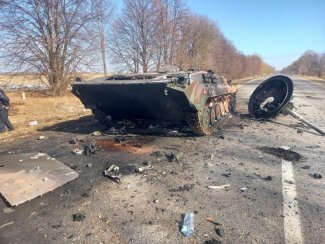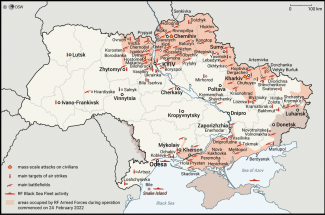Russia’s war against Ukraine: day 6

On the sixth day of the operation, the Armed Forces of the Russian Federation intensified their attacks on units of the Ukrainian army, and – especially during the night of 1/2 March – continued their air and missile strikes on cities located in the combat zones, including civilian facilities. Artillery (mainly rocket) located on the outskirts of the cities is also being fired. Kharkiv has suffered the most damage, although infrastructure losses in Chernihiv, Mikolayiv and many smaller towns in eastern Ukraine are increasing (Volnovach, a town of 20,000, has effectively been destroyed). In Kyiv, the Russians fired at the broadcasting installation on the TV tower, which temporarily stopped broadcasting terrestrial TV signals.
In the north and north-east (referred to in Ukrainian military nomenclature as the Polessie and Severny directions), Ukrainian units continue to be pushed towards the capital. The city is preparing to repel the attack, and clashes with Russian sabotage and reconnaissance groups are underway. From the west, Russian forces have reached the borders of Kyiv, while from the north and east, the defenders have been able to halt the aggressor at a distance of between 10 and 30 kilometres from the city. The Russian forces’ progress north-eastwards allowed the remaining Ukrainian sub-units to temporarily regain control over the section of the Kyiv–Moscow highway. Chernihiv is getting ready to repel the attack (its defenders have allegedly mined all the access roads to the city). In the north, the Russians have begun to expand their area of operations south-westwards, attacking Zhytomyr (bombing at night, while fighting continues on the town’s outskirts).
After breaking through the Ukrainian defence lines around the encircled city of Kharkiv (in the Slobodka direction), the Russian forces continued their offensive westwards: they reached Krasnohrad and launched an auxiliary attack direction on Izium, where they were successfully stopped by Ukrainian troops. The line of defence in Sumy oblast has been maintained; a local exchange of POWs took place there on 1 March, the first such since the Russian attack on Ukraine began. The so-called separatists in Donbas have made some slight progress; the main fighting there is in the area of Mariupol, which – like Kharkiv – has now been completely encircled (including from the sea).
After a one-day break, the Russian offensive in the south (the Taurida direction) is unfolding. After clashes overnight, Russian forces appear to have seized the first major city in the region, Kherson. Fighting for Mykolayiv is underway, and Russian troops have also approached Zaporizhia (the city was bombed during the night), encircling the city from the east. After the encirclement of Kherson (even before its occupation) and Mykolayiv, the Russian columns began to move northwards, clashing with Ukrainian units in positions 50–70 km north of both cities. A landing group of the combined Black Sea, Baltic and Northern fleets is moving towards Odesa.
The Ukrainian General Staff of the Armed Forces provided information that illustrates the pushes being made by the Russian army in specific directions. Within Ukraine, there are now around 120,000 Russian soldiers (80% of the land potential accumulated before the invasion). The strongest groups are attacking Kyiv from the Chernihiv region (17 battalion tactical groups, BTGs) and the Dnieper from the Kharkiv region (16 BTGs). In the remaining directions, the Russian forces consist of two to five battalion tactical groups, which means that their task is mainly to tie up and blockade the movements of Ukrainian troops. However, no information has been released about the size of the group attacking Kyiv from the north and west.
Ukraine reports that during the six days of the invasion, the aggressor has lost 5840 soldiers, 30 aircraft, 31 helicopters, 211 tanks, 862 armoured combat vehicles, 85 artillery systems, 40 multiple rocket launchers, 355 trucks, 2 boats, 3 unmanned aerial vehicles and 60 fuel tanks. It was emphasised that these data are not precise, and the calculations are complicated by the high intensity of hostilities. According to the Russian Defence Ministry, since the beginning of the operation, the Russian Armed Forces have destroyed 1502 infrastructure facilities of the Ukrainian Armed Forces (including 51 command posts, 51 radar stations and 38 air defence missile systems), 47 aircraft on the ground and 11 in the air, 472 tanks and other armoured combat vehicles, 62 multi-missile launchers, 206 guns and mortars, 336 specialised military vehicles and 46 unmanned aerial vehicles.
The Digitisation Ministry has launched a fundraising website for the reconstruction of Ukraine and its army. The ministry has also introduced an ‘Air Alert’ mobile application, which sends alerts about air raid warnings and other alarms, even if the smartphone is in mute or sleep mode. In turn, the local authorities are strengthening internet connectivity by installing wireless internet transmitters.
The Ukrainian government has announced the beginning of a cyber-offensive against Russia with the participation of government agencies, intelligence services, hackers and the entire patriotic IT community: they have called for participation in the ‘information war’, and asked hackers to join the ranks of the ‘Internet Forces of Ukraine’ to counteract fake news and spread real news among Russians about the nature of the aggression. The hacker group NB65, linked to the Anonymous cyber-collective, blocked the Roskosmos website and announced that it had breached the security of the Russian satellite control system. Moscow denied these reports, but this reassurance did not counteract the hackers’ global message highlighting the weakness of Russia’s security systems. Access to the websites of the Kremlin, the Ministry of the Interior, the FSB, the Ministry of Justice and the Ministry of Defence of the Russian Federation has been effectively blocked.
President Zelenskiy’s speech to the European Parliament, in which he movingly appealed for all possible steps to stop further aggression to be taken, preceded the body’s resolution recommending Ukraine’s accession to the EU. The president called Russia’s actions state terror, and reiterated his call to bring Russian decision-makers before the International Criminal Court for acts of a genocidal nature (the first hearings to this end will be held on 7–8 March). Kyiv believes that only a complete ceasefire can be a precondition for starting the second round of negotiations.
Over the last five days, around 80,000 people, mainly men, have returned to Ukraine to resist the aggressor. At the same time, the exodus of civilians to Poland and other EU countries is continuing. Since the beginning of the invasion, 453,000 people have crossed the border with Poland, including 98,000 on 1 March alone. During the same period, 140,000 people have crossed the border points in the Transcarpathian region, heading for Slovakia, Hungary and Romania. The Lviv region has hosted 40,000 internal refugees (excluding people who are staying with family or friends), and has declared that they will accept another 20,000 in the coming days, while further expanding their options for accommodation. At the same time, the mayor of Lviv has called on men of recruiting age among the refugees to join the ranks of the territorial defence forces, or to return to their cities and help in their protection.
As a result of the missile and air missiles on many cities, more civilians died on 1 March, but there are no current collective data: in Kharkiv 21 deaths have been reported, in Zhytomyr 2, and in Kyiv 5. Two people who were visiting Babi Yar – the place of extermination of over 100,000 victims of the Nazis during World War II – were among the victims of the air raid in the capital. Zelenskiy made an appeal to Jewish communities from all over the world, in which he compared the shelling of Babi Yar and Uman (places of sacred importance for Jews) to the actions of the Nazis, and accused the Russians of murdering the victims of the Holocaust a second time.
Commentary
- The escalation of activity has translated into an increase in Russian airborne activity. The Russians are still not using aviation on a massive scale, but it is now being employed in the combat areas on a permanent basis. This is favoured by the depletion of Ukraine’s aviation potential, as confirmed by the command of the Ukrainian Air Force. Since 28 February, the Ukrainian side has reported that only one or two Russian planes and helicopters have been shot down each day, while in previous days the number of kills was supposed to have reached up to a dozen a day). The Russian air force’s activities are one of the main causes of the numerous casualties among the population and damage to the civil infrastructure, and – in conditions of air domination – they are indisputably criminal in nature. Russia has used forces in its attacks on the cities which it had not used in the earlier phase of the conflict – tactical Su-34 bombers and strategic Tu-22M3 bombers.
- Russian forces have cemented their breakthrough of the Ukrainian army’s existing lines of defence, forcing it to withdraw and regroup its units (except in those areas where Ukrainian forces have been encircled and blocked off). In the north-east, Russian troops advancing towards Kyiv simply bypassed the smaller Ukrainian units without blocking them. Currently, these units are able to harm the aggressor’s groups in its hinterland, but – apart from their own logistics – they will ultimately be forced to break through to the west, or abandon their heavy weapons and military equipment and switch to guerrilla-style operations. There is no information on the number of groups attacking Kyiv from Belarus, or from Kherson and Mariupol to the north. However, it should be assumed that their potential exceeds that of the local Ukrainian forces. This situation is confirmed by reports that new Russian units are being introduced from Belarusian territory (up to nine battalion tactical groups) and from Crimea.
- The Ukrainian government has successfully been organising new forms of social resistance. The hackers’ involvement in paralysing the Russian internet can be considered a success. Their effective interference with the security systems of state institutions, including the Kremlin, shows how important the call for a ‘mass action’ online has been as a component of defence activities. Internet campaigns are also important from the perspective of rebutting the Russian message about the course of the war, as it allows information about the aggressor’s losses to be spread. As a result of these effective Ukrainian actions, the Russian propaganda apparatus has lost its advantage. Its building of an anti-Ukrainian narrative is aimed at Russian society alone, and remains completely implausible to audiences outside of Russia. Despite the enormous financial resources involved, Russia’s own disinformation activities have had little effect, and have not isolated Russian society from the information pressure organised by Ukraine, which is aimed at lowering the Russian people’s morale.
- Despite the dramatic situation in many towns and cities, Ukrainian society is beginning to adapt to the difficult conditions. People are ‘settling down’ in the shelters, where they are spending a great deal of time due to the frequent anti-aircraft alarms. They have also consistently shown solidarity towards those in need. Attitudes of resistance persist: in cities controlled by Russian troops, residents are engaging in combat, learning to prepare and throw Molotov cocktails, and going out to protests in city centres, during which they stand in front of Russian units, refuse to show them documents, or curse them. 80% of Ukrainian citizens have declared that they want to defend the country with arms in hand. At the same time, the statements made by local authorities are showing signs of increasing desperation, as they are unable to oppose the Russians with more meaningful or effective military force.
(Text was completed on 2 March at 12 pm CET)
Map. The Russian attack on Ukraine (as of 2 March 11 am CET)





